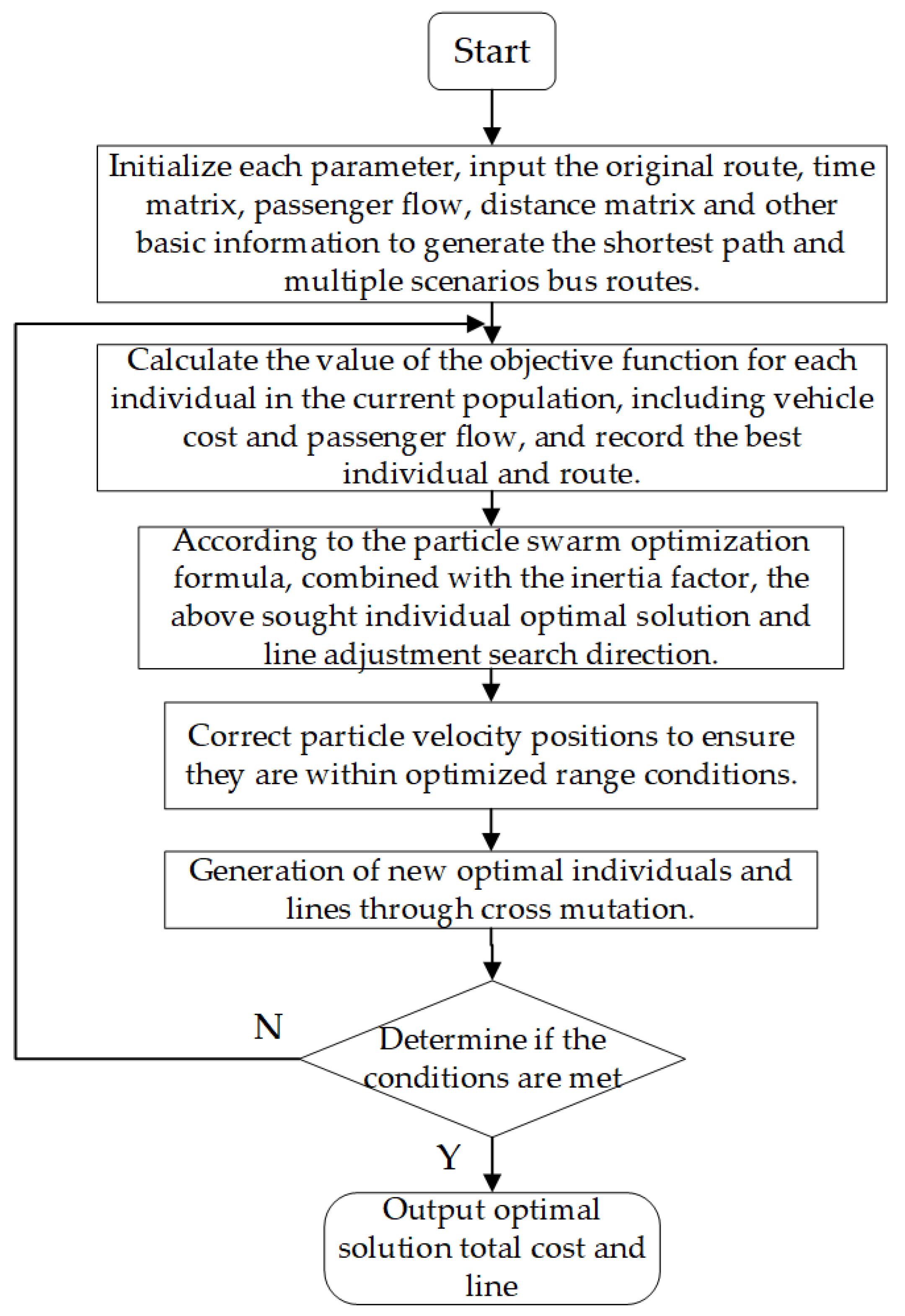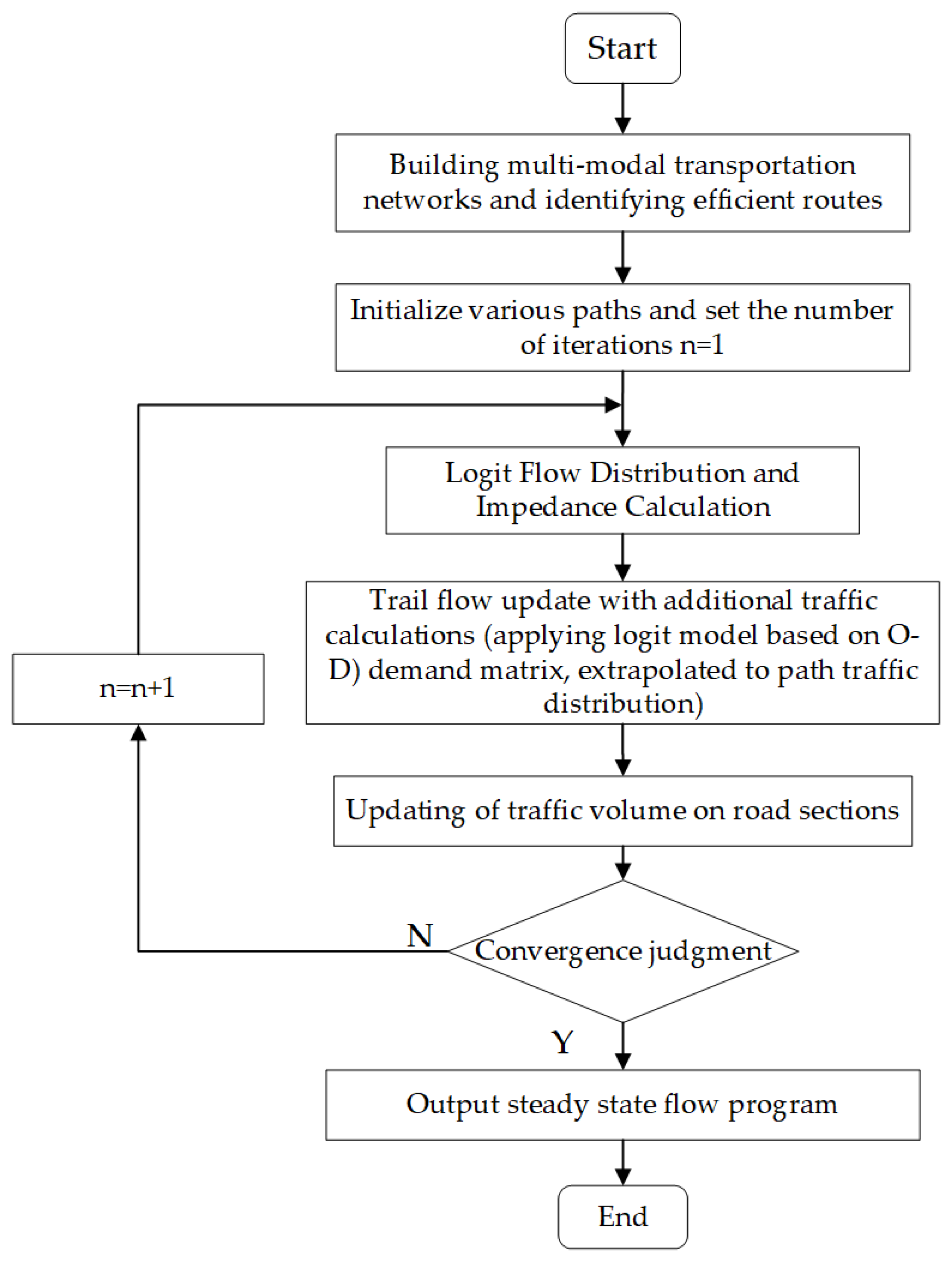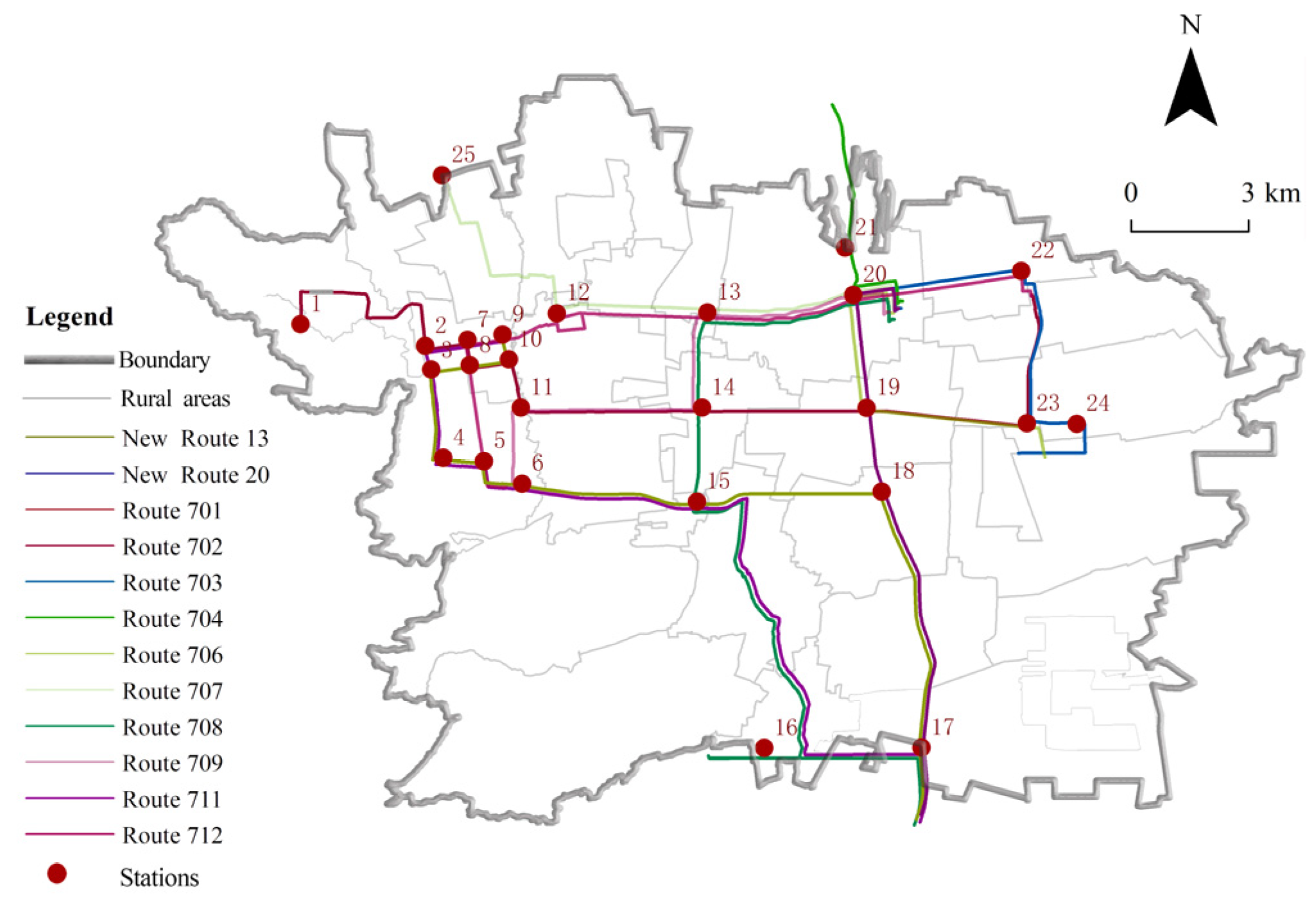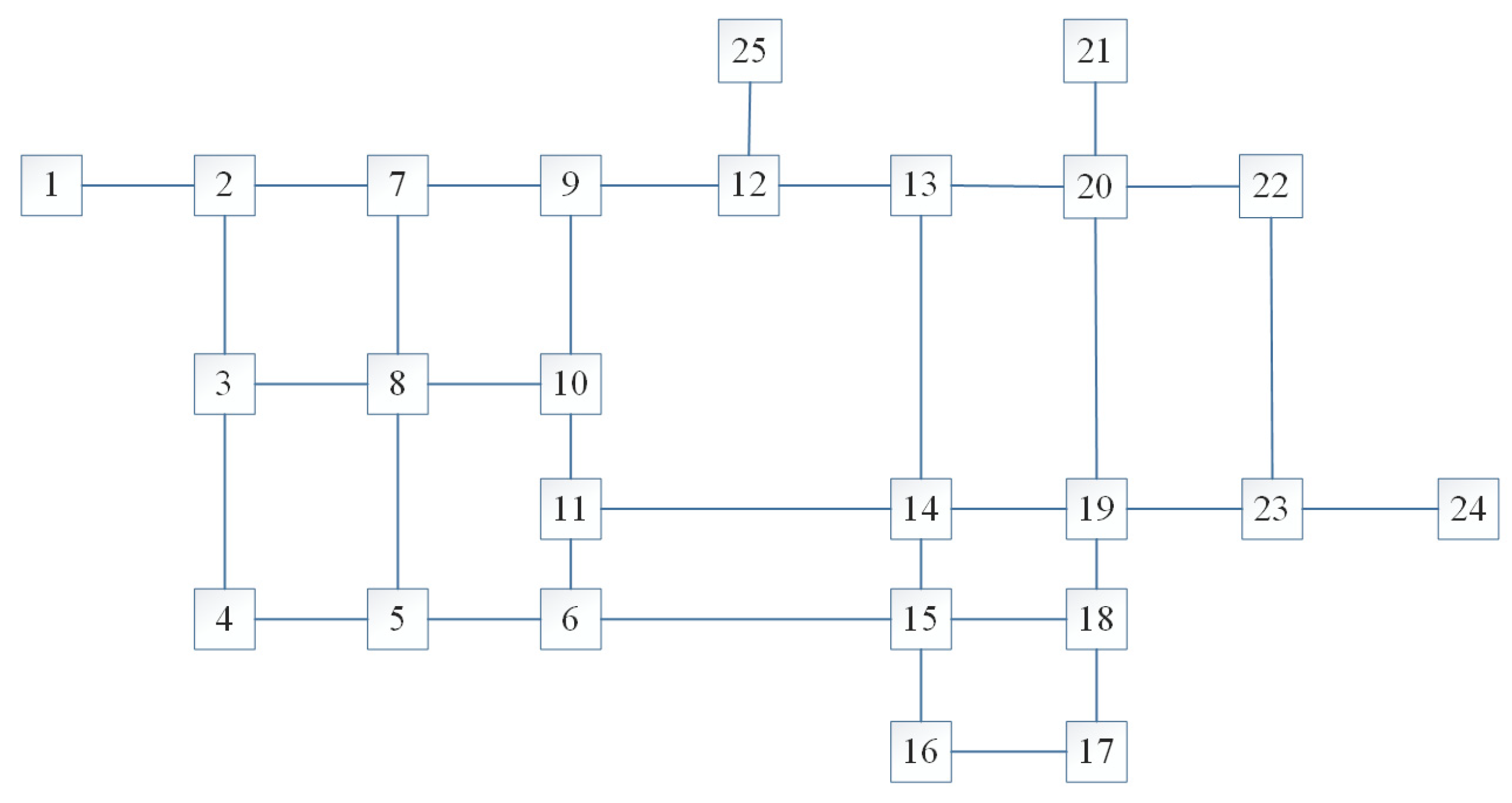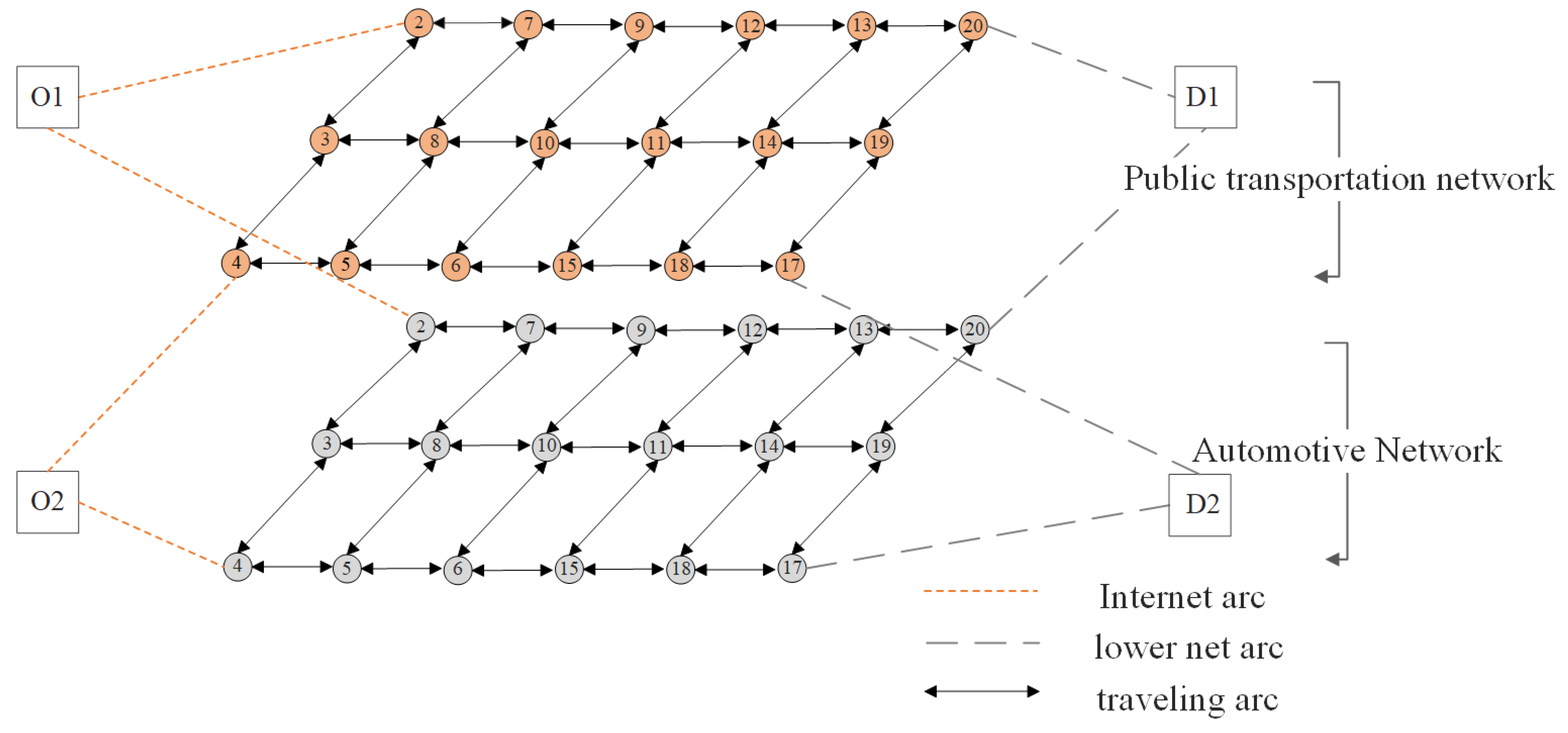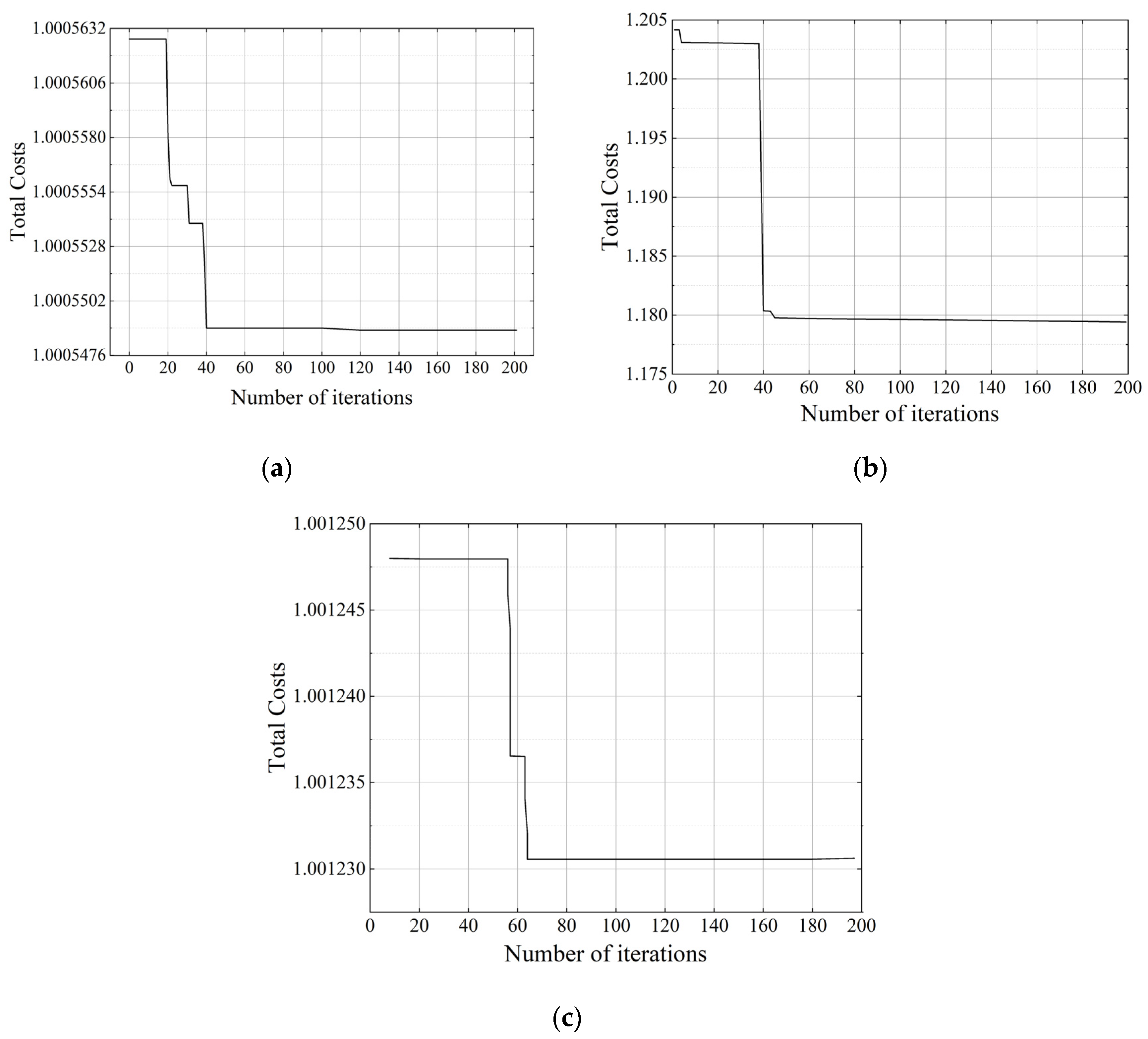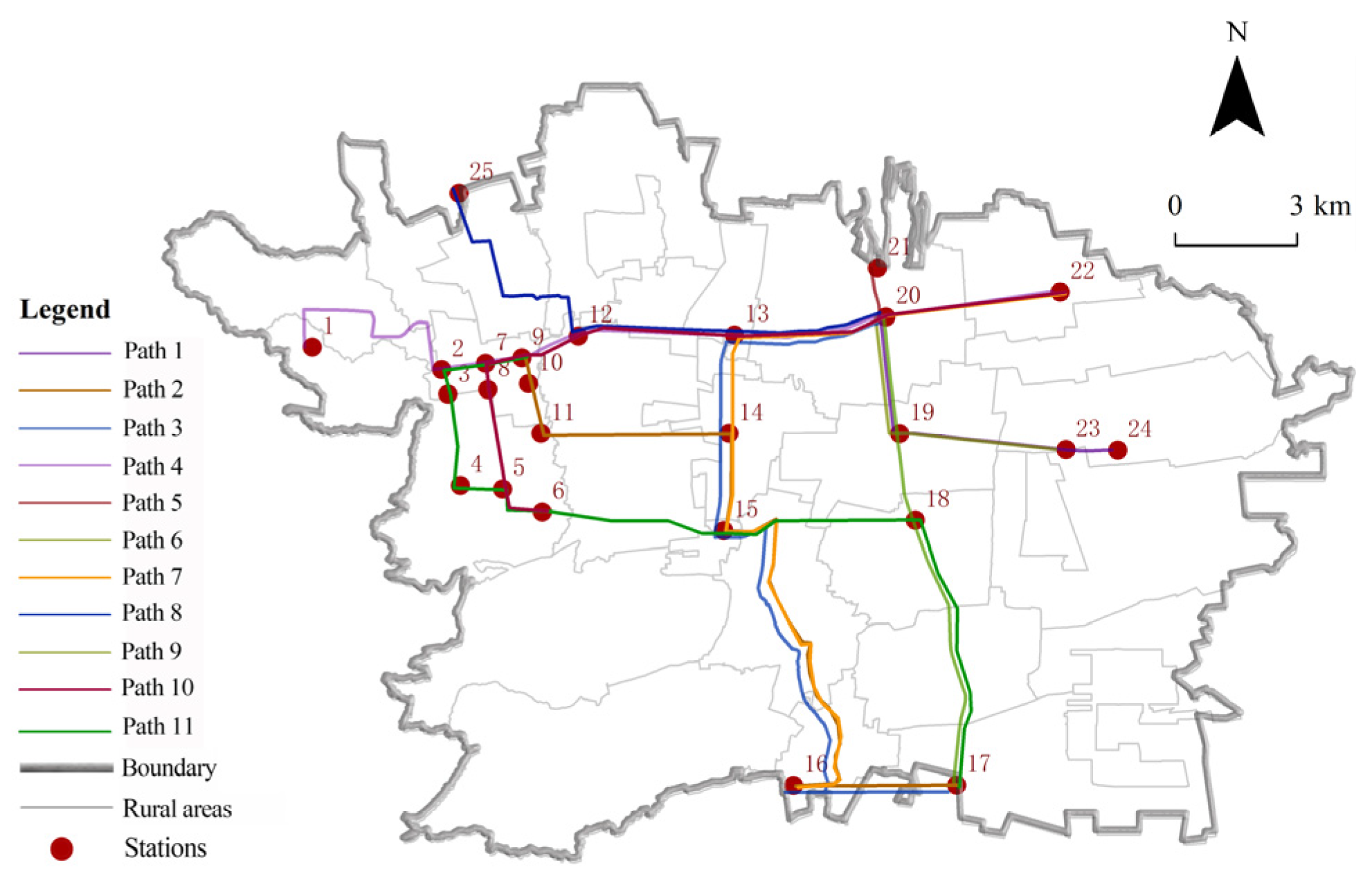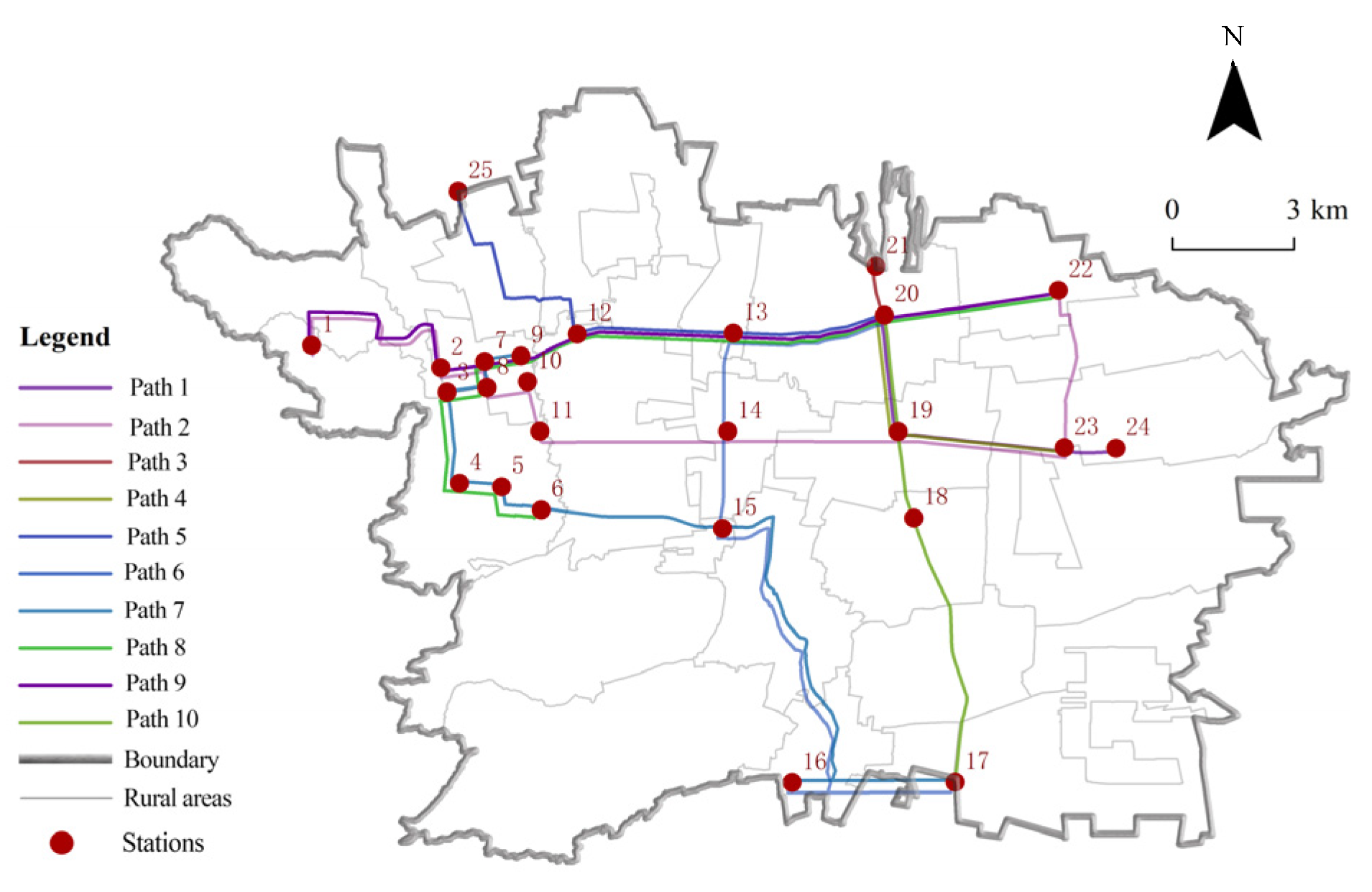1. Introduction
The structural characteristics of dispersed population and uneven spatial and temporal distributions of travel demand have long constrained the development of public transportation in low-density rural areas. It is generally faced with the dual challenges of insufficient service coverage and operational inefficiency, which are deeply mired in the structural contradiction of imbalance between supply and demand [
1]. This low accessibility not only significantly increases the travel costs of residents but also reinforces their reliance on private motorized travel, leading to increased carbon emissions and loss of social welfare. A particular operational dilemma in such systems is the “pulse service” model. While this model guarantees minimum accessibility in the spatial dimension, it faces long waiting times at the expense of convenience. To solve this systemic problem, policies such as the Action Plan for the Construction of Digital Villages (2022–2025) explicitly propose the construction of an “integrated transport and postal” logistics service network to improve resource utilization efficiency. In this context, how to build a scientific transportation resource allocation model to effectively alleviate or even reconstruct the prevalent “pulse service” [
2] mode under the established resource constraints, to bridge the “service faults” caused by it, and to enhance the convenience and fairness of the service become key issues that need to be resolved urgently to promote the equalization of public services in urban and rural areas.
Transportation as an important basis for social activities, resource allocation, and service provision must reflect the concept of social equity [
3]. In the field of transportation, the core of the fairness problem is reflected in the spatial displacement capacity constraints caused by the uneven distribution of resources [
4]. Existing empirical studies based on the theoretical framework of transportation equity show that the resource allocation of the transportation system presents significant three-dimensional spatial heterogeneity (accessibility, affordability, and quality of service), resulting in disadvantaged groups facing multi-dimensional institutional barriers superimposed on each other, forming a spatial equity allocation of the justice gap [
5,
6].
Accessibility and equity centrality: Accessibility, classically defined as an individual’s access to jobs and urban services under specific spatio-temporal constraints (e.g., 30-min thresholds), is a core dimension of transportation equity [
7,
8] (usually based on a 30-min threshold) [
9,
10]. Martens and Golub [
11] emphasized that accessibility is not only a spatial mobility metric but also an essential condition for social participation and pointed out the public responsibility of the government in providing accessibility, laying down an important benchmark for subsequent studies. From the dimension of resource allocation, Guzman et al. [
12] constructed a mobility equity index to reveal the spatial differentiation pattern of urban and rural transportation services. In environmental justice, the latest research confirms that the negative externality of the transportation infrastructure has a spatial transfer phenomenon, forming a typical “spatial deprivation” effect [
13]. At the methodological level, academics have made important progress in indicator innovation. Caggiani et al. [
14] used the road network affiliation function constructed by the fuzzy set theory to successfully portray the nonlinear characteristics of accessibility decay in marginal areas; Ballantyne [
15] developed a small-scale multi-modal transportation evaluation system, which provides a refined analytical tool for urban decision-making; and Palm et al. [
16] developed a social equity impact assessment model for NMT and transit integration based on new transit pilot data. However, there are still obvious limitations in the existing studies. First, it is difficult for traditional evaluation indicators to effectively characterize the imbalance between supply and demand in low-density areas [
17,
18]; second, there is a group selection bias in the perspective of the study, which overly focuses on the disadvantaged groups and neglects the spatial benefit mechanism of the advantaged groups [
19,
20], resulting in a lack of holistic knowledge of the structure of the distribution of the benefits of transportation; third, the established results mostly use cross-sectional data analysis, which is difficult for revealing the dynamic evolution law of transportation resource allocation and its institutional causes [
21].
The bus route network optimization research paradigm has shifted from the traditional stage of demand forecasting to intelligent algorithm-driven forecasting. The classical path assignment model relies on the shortest path principle to construct a static demand response mechanism [
22]. Subsequent scholars have improved the prediction accuracy by introducing a generalized path selection mechanism (GNL model) [
23], and the hybrid perturbation assignment method further incorporates the traveler behavioral heterogeneity parameter, which significantly enhances the reliability of the model [
24]. Along with the advancement of computing technology, the bionic optimization algorithm triggers methodological innovation. Bionic optimization algorithms, such as immunogenetic algorithms [
25] and improved particle swarm algorithms [
26], promote methodological innovations, and multidimensional resource allocation models [
27] mark the evolution of optimization frameworks towards systematization. Stochastic planning models [
28] have made a breakthrough in dynamic resource allocation. There is the multi-objective synergistic optimization trend, where research is shifting from single cost minimization [
29,
30,
31] to multi-objective synergy, such as efficiency, equity, and sustainability. Lin [
32] integrated economic and environmental costs to achieve the synergistic optimization of service coverage and route efficiency; Ma et al. [
33] integrated a mixed-integer planning model that jointly optimized vehicle paths and passenger assignments to enhance the resilience of customized buses. However, there are three core shortcomings in the established studies. First, there is insufficient modeling of the stochastic nature of OD (origin–destination) passenger flows and a lack of effective portrayal of how demand fluctuations dynamically affect resource utilization [
34,
35]; second, with the weak design of the multi-objective synergistic mechanism, linear weighting method-dominated solutions are susceptible to the interference of subjective weighting, and it is difficult to resolve the nonlinear coupling relationship between objectives [
36,
37]; and third, algorithmic innovation is disconnected from the quantification of equity. Although evolutionary algorithms such as NSGA-II maintain population diversity through crowding strategies [
38], they fail to construct an evaluation system that is articulated with spatial fairness theories. Sun et al. [
39] and their multi-site vehicle scheduling model made progress in cost control, but it still has not broken through the above bottlenecks. The deterministic assumption also limits the application scope of the improved immunogenetic algorithm (IIGA) of Ma et al. [
40].
Aiming at the above research limitations, this paper proposed a two-layer planning model integrating transportation equity constraints, focusing on the multidimensional equity imbalance in the “county–village–village” transportation system, and constructing a multimodal transportation equity analysis framework including spatial accessibility, right-of-way allocation, and cost internalization. The main contents were to (i) establish a two-dimensional fairness evaluation system based on the Gini coefficient of road area and the relative deprivation coefficient of travel cost that breaks through the limitations of the traditional single-indicator metrics; (ii) construct a two-layer planning traffic network model, considering the differentiation of the right-of-way allocation, which realizes the synergistic operation of the bus-only lanes and the conventional roads through physical segregation; and (iii) design multi-objective optimization algorithms, combining the NSGA-II intelligent algorithm and two-layer planning model to realize the optimization of efficiency and fairness. By constructing a systematic framework of “demand analysis, road network modeling, costing, algorithmic optimization”, a new methodology was provided to support the allocation of transportation resources in low-density rural areas.
4. Discussion
This study achieved a dual breakthrough at the theoretical and practical levels by constructing a fusion framework of a two-layer planning model and an adaptive genetic algorithm. At the theoretical level, the model effectively balanced the conflicts of interests of multiple subjects in urban and rural transit systems, and the integrated optimization scheme reduced the Gini coefficient by 0.79%, which verified the potential of the two-layer planning model to enhance the fairness of resource allocation. Compared with single-objective optimization studies [
50,
51], the two-layer model avoided the trap of a “zero-sum game” through Pareto improvement and confirmed the necessity of impulse service for low-density road networks in the case of Qinchuan Town, which guaranteed the coverage of basic service at the expense of operational efficiency. Basic service coverage was guaranteed at the expense of operational efficiency. At the practical level, the innovative data enhancement method broke through the traditional gravity model constraints through the spatial weight correction factor, which provided a new paradigm for rural transportation data modeling; at the algorithmic level, the dynamic inertia factor mechanism reduced the number of convergence iterations to 64, which improved the efficiency of the standard genetic algorithm [
52]. The multidimensional fairness assessment system constructed through the Gini coefficient compensated for the blind spot of the traditional indicators for the imbalance in the allocation of resources.
However, the study still had three limitations. First, the static OD data and peak assumptions did not cover dynamic passenger flow characteristics, such as seasonal population migration, which may weaken the route flexibility. Second, the “Spatial Enhancement Method Based on Travel Behavioral Characteristics” adopted in this study solved the problem of model failure due to small original data flow by amplifying the original sparse OD data. However, it did not consider the dynamic change in travel and the competition of external traffic, and the generated data only represented an average state and could not predict unexpected events. Third, the model simplified the impact of policy variables, such as government subsidies on fares, which led to the deviation of the cost-sharing mechanism from reality. The generalization of the findings from a single suburban case to high-density villages or mountainous areas needs further validation. Future research can make breakthroughs in three aspects: constructing a responsive scheduling system [
52] by integrating real-time GPS data to dynamically optimize route resources; exploring the feeder network of buses with shared bicycles and micro-circulation buses to make up for the coverage blindness with multi-modal transportation; and establishing a policy-sensitive analysis framework to quantify the marginal impacts of variables, such as financial subsidies, on the optimization results to provide decision-making support for collaborative governance between government and enterprises.
To achieve a fairer and more efficient urban and rural transportation system, the transportation department should give priority to adopting a multi-objective planning framework, which needs to clearly integrate fairness indicators and operational efficiency goals. The two-layer optimization model constructed in this study proved that it is feasible to achieve Pareto improvement through such a framework, transcending the traditional zero-sum trade-off dilemma. Thus, it provides solid decision support for the government–enterprise collaborative governance model necessary for sustainable rural transportation development.
